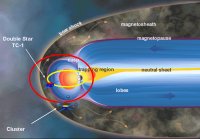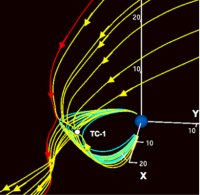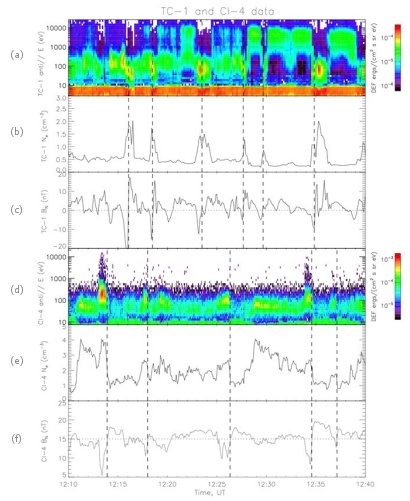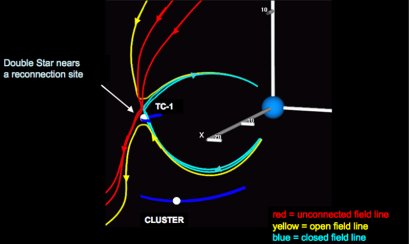Double Star and Cluster witness pulsated reconnection for several hours
3 October 2006
Using coordinated observations of the CNSA/ESA Double Star and ESA/NASA Cluster missions, a team of European and US scientists reveals new features of magnetic reconnection at the Earth's magnetopause. These results improve our knowledge on how, where and under which conditions the solar wind manages to penetrate the Earth's magnetic shield on the flank of the magnetosphere.
 |
|
Image 1. Sketch of the Earth's magnetosphere with the orbit of the Double Star TC-1 spacecraft (in yellow) and the Cluster satellite quartet (in red) around May 2004. |
Thanks to its internal magnetic field, the Earth is protected from the continuous stream of particles blown by the Sun: the solar wind. The Earth's magnetic sphere of influence is called the magnetosphere and the boundary layer separating the magnetosphere from the solar wind the magnetopause. However, the magnetopause is not an impenetrable shield.
The transport of mass, but also energy and momentum, across the magnetopause is a central issue in space physics. Consequences of this transport are of major concern for space weather specialists worldwide, monitoring our Earth's space environment and technology infrastructure. One long-term goal is to accurately forecast the occurrence of magnetic storms and their consequences on critical technology infrastructure both in space and on Earth (satellite failures, inaccurate GPS positioning, pipeline corrosion...). To reach that goal, the knowledge on how, where and under which conditions, solar material penetrates the Earth's magnetic shield is of crucial importance.
Magnetic reconnection and Flux Transfer Events (FTEs)
Magnetic reconnection is one of the most efficient mechanisms in this matter. The basic idea behind reconnection is that anti-parallel magnetic field lines from different magnetic domains can, when meeting, merge together and change the overall magnetic field topology. This topological change leads in particular to the mixing of previously separated plasmas, and converts magnetic energy to particle energy, generating plasma jets and plasma heating. At the magnetopause, it occurs when Earth's magnetic field lines interconnect with Interplanetary Magnetic Field (IMF) lines carried by the solar wind. This topological change of the magnetic field allows solar material to enter along the connected field lines.
This phenomenon was imagined in the 50's as a large-scale steady state process. Since the late 70's, several studies have shown the existence of pulsed reconnection at the magnetopause producing spatially confined magnetic flux tubes called flux transfer events (FTEs). Typically of a few minutes duration, these FTEs propagate away from the reconnection site and are often used as a tracer of magnetic reconnection.
Simultaneous observations of FTEs by Cluster and Double Star TC-1
On 8 May 2004, the four Cluster spacecraft and the Double Star TC-1 satellite were both in the vicinity of the magnetopause. The five spacecraft were on the dawn side flank of the magnetosphere in the southern hemisphere, with TC-1 located near the equatorial plane and Cluster at higher geographic latitudes. TC-1, at its apogee, skimmed the magnetopause for almost 8 hours (between 08:00–16:00 UT), while Cluster with its polar orbit crossed the magnetopause at around 10:30 UT in the same Magnetic Local Time (MLT) sector and remained close to the magnetopause (image 1).
FTEs moving southward/tailward from the reconnection site, were observed by TC-1 during almost 8 hours, while the four Cluster spacecraft observed FTEs for a period of 6.5 hours between 07:30 and 14:00 UT.
Pulsed magnetic reconnection during 8 hours
The properties of FTEs observed by both TC-1 and Cluster are in agreement with previous observations. Detailed analysis of TC-1 data reveal in particular that plasma acceleration was taking place at the reconnection site, located near the TC-1 location. Cluster data are generally consistent with plasma precipitating along the field lines in the direction of the southern ionosphere (image 2).
All five spacecraft observed clear and successive FTE signatures with a repetition rate of 4 minutes for TC-1 to 8 minutes for Cluster, hence the existence of pulsed reconnection. The transverse size of the FTEs was estimated between 4500 and 24 000 km, in agreement with previous studies.
"The very clear signatures and the finite transverse sizes of the FTEs, observed both by TC-1 and Cluster, suggest the sporadic nature of the reconnection process, even for a period as long as ~8 hours", wrote Dr. Aurélie Marchaudon, lead author of this study published 08 November 2005 in Annales Geophysicae. Dr. Marchaudon is a scientist at the Laboratoire de Physique et Chimie de l'Environnement, Centre Nationale de la Recherche Scientifique (CNRS) and Université d'Orléans, Orléans, France.
Characteristics of the reconnection site
 |
|
Image 4. Close-up of image 3 as viewed from the Sun. It reveals the formation of a reconnection site (also called merging line) extending from about 7 to 10 MLT. |
This result is in agreement with previous studies showing that reconnection on the dayside is not simply controlled by the IMF-Bz but rather by the IMF clock angle.
Moreover, simultaneous measurements of FTEs by Cluster and Double Star imply that the spatial extent of the reconnection site was at least ~ 2 hours in Magnetic Local Time (MLT).
A numerical simulation based on a global MagnetoHydroDynamic (MHD) model was run to reproduce the 8 May 2004 event. Image 3 shows the topology of the magnetic field produced by the global MHD model around 10:00 UT. The field lines displayed show reconnection occurring just above the equatorial magnetopause precisely where TC-1 was skimming. "This topology is consistent with fast plasma flows measured by the HIA ion and PEACE electron experiments onboard TC-1, as well as with the polarities of the numerous FTEs observed on that pass", says Dr. Jean Berchem, scientist at the University of California Los Angeles (UCLA), USA who simulated this event. Image 4 displays a close-up of the same scene but viewed from the Sun. It reveals the formation of a reconnection site extending about 7 to 10 MLT, in agreement with the data collected by both Double Star TC-1 and Cluster.
Double Star and Cluster synergy
"After significant results achieved in the magnetotail (see: March 2006 story), the solar wind (see: June 2006 story) but also on magnetar SGR-1806 (see: September 2005), Cluster and Double Star observations now reveal new facts on the behaviour of magnetic reconnection at the magnetopause, inaccessible to one mission alone. This new result once again illustrates the mutual benefit of having Cluster and Double Star flying in concert. The positions and orbit of the Double Star satellites have been carefully defined to enable the exploration of the magnetosphere on a larger scale than is possible with Cluster alone. The on-going coordinated observations, together with the benefit of having Cluster derived instruments partly composing the scientific payload of both Double Star satellites, pay off", says Philippe Escoubet, Cluster and Double Star project scientist of the European Space Agency.
Marchaudon, A., C. J. Owen, J.-M. Bosqued, R.C. Fear, A.N. Fazakerley, M.W. Dunlop, A. D. Lahiff, C. Carr, A. Balogh, P.-A. Lindqvist and H. Rème, Simultaneous Double Star and Cluster FTEs observations on the dawnside flank of the magnetosphere, Ann. Geophys., 23, 2877-2887, 2005
Related articles
Berchem, J., A. Marchaudon, J. M. Bosqued, C. P. Escoubet, M. Dunlop, C. J. Owen, H. Reme, A. Balogh, C. Carr, A. N. Fazakerley, and J. Cao, Using DOUBLE STAR and CLUSTER synoptic observations to test global MHD simulations of the large-scale topology of the dayside merging region, Eos Trans. AGU, 86(52), Fall Meet. Suppl., Abstract SM23-06, 2005
June 2006 story: Cluster and Double Star discover density holes in the solar wind
March 2006 story: Cluster/Double Star reveal the extent of neutral sheet oscillations
September 2005 story: Double Star and Cluster reveal crustal cracking on a magnetar
Contact
Main Author
Aurélie Marchadon
LPCE/CNRS and Université d'Orléans, Orléans, France
e-mail: Aurelie.Marchaudon
 cnrs-orleans.fr
cnrs-orleans.frphone: +33-2-38-25-79-83
Web story author and co-editor
Arnaud Masson
SCI-SO division, RSSD, ESA, The Netherlands.
e-mail: Arnaud.Masson esa.int
esa.int
phone: +31-71-565-5634
Web story editor
Philippe Escoubet
SCI-SM division RSSD, ESA, The Netherlands.
e-mail: Philippe.Escoubet esa.int
esa.int
phone: +31-71-565-4564



